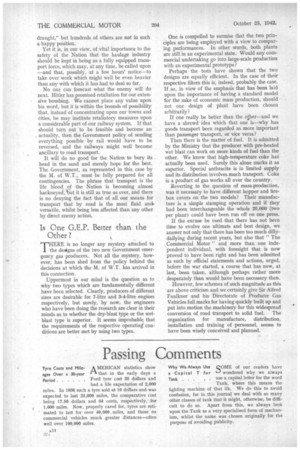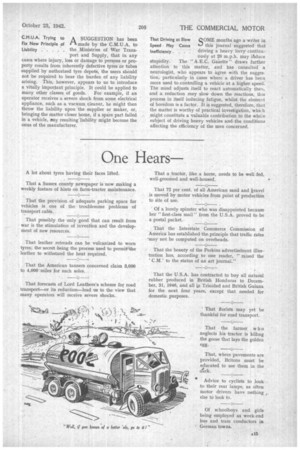Passing Comments
Page 16

Page 17

If you've noticed an error in this article please click here to report it so we can fix it.
Tyre Costs and MileA MERICAN statistics show
ages Over a 30-year that in the early days a Period Ford tyre cost 35 dollars and had a life expectation of 2,000 miles. In 1938 such a tyre sold at 16 dollars and was expected to last 25,000 miles, the comparative cost being 17.50 dollars and 64 cents, respectively, for 1,000 miles. Now, properly cared for, tyres are estimated to last for over 40,000 miles, and those on commercial vehicles much greater distances—often well over 100,000 miles. Why We Always Use ROME of our readers have a Capital T for kJ wondered why we always Tank • • • use a capital letter for the word
Tank, where this means the fighting machine of that ilk. We do this to avoid confusion, for in this journal we deal with so many other classes of tank that it might, otherwise, be difficult to do so. Apart from this, we always look upon the Tank as a very specialized form of mechanizm, whilst the name was chosen originally for the purpose of avoiding publicity. C.M.U.A. Trying to A SUGGESTION has been
Fix New Principle of made by the C.M.U.A. to Liability the Ministries of War Trans port and Supply, that in any cases where injury, loss or damage to persons or property results from inherently defective tyres or tubes supplied by authorized tyre depots, the users should not be required to bear the burden of any liability arising. This, however, appears to us to introduce a vitally important principle. It could be applied to many other classes of goods. For example, if an operator receives a severe shock from some electrical appliance, such as a vacuum cleaner, he might then throw the liability upon the supplier or maker, or, bringing the matter closer home, if a spire part failed in a vehicle, any resulting liability might become the onus of the manufacturer. That Driving at Slow ROME months ago a writer in
Speed May Cause 0-1 this journal suggested that
Inefficiency . . ously at 20 m.p.h. may ifiduce driving a heavy lorry continu stupidity. The " A.E.C. Gazette " draws further attention to this matter, and has consulted a neurologist, who appears to agree with the suggestion, particularly in cases where a driver has been more used to controlling a vehicle at a higher speed. The mind adjusts itself to react automatically then, and a reduction may slow down the reactions, this process in itself inducing fatigue, whilst the element of boredom is a factor. It is suggested, therefore, that the matter is worthy of practical investigation, which might constitute a valuable contribution to the whole subject of driving heavy vehicles and ,the conditions affecting the efficiency of the men concerned.




















































